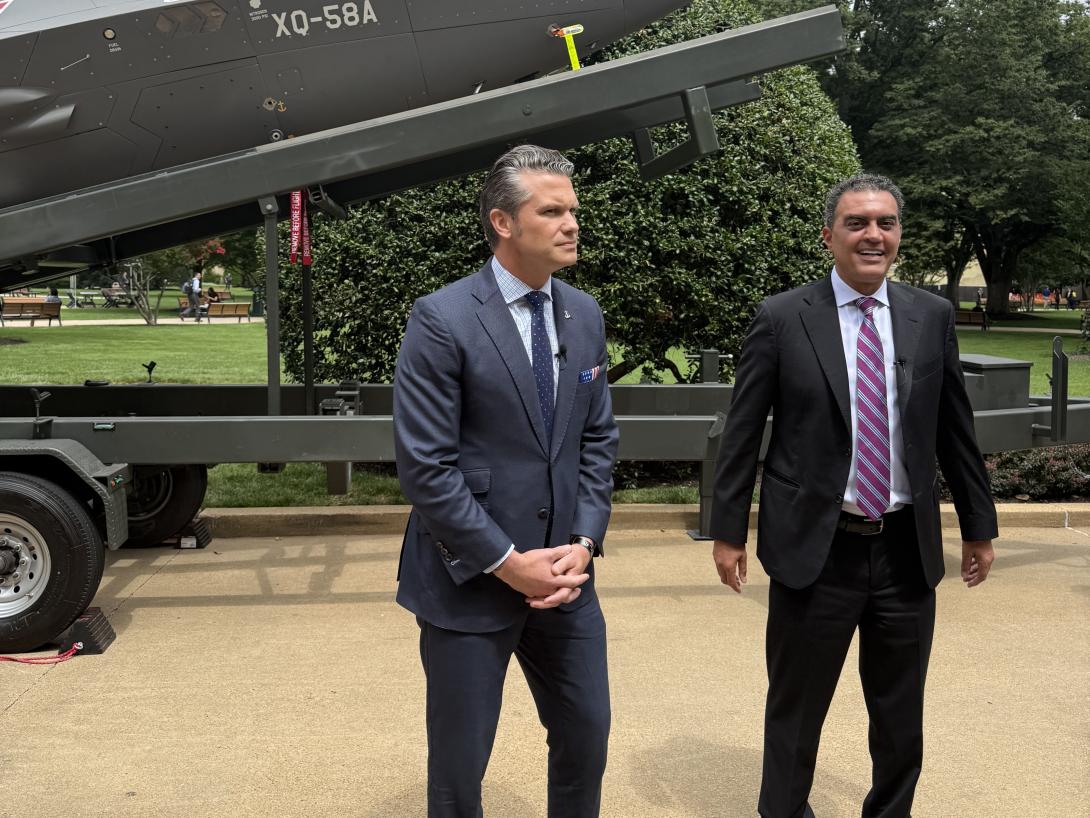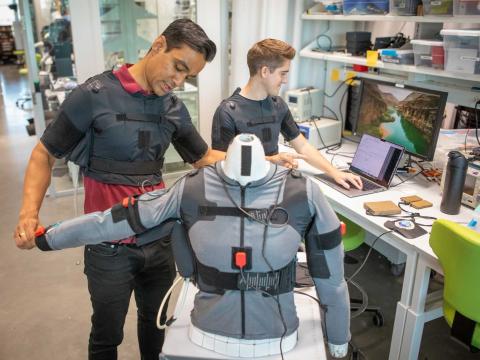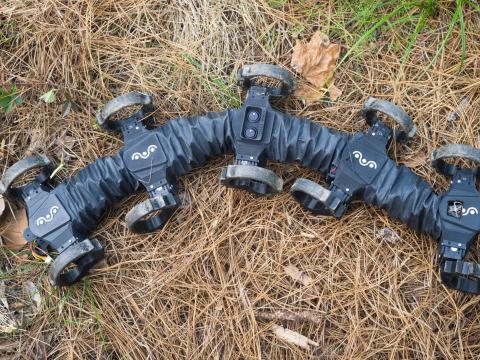Drones Are the Priority
The Department of Defense’s (DOD’s) advanced technology development organization, the Office of the Under Secretary of Defense for Research and Engineering, is setting unmanned aircraft systems (UAS) as a priority for the next several years, based on directives from the secretary of defense and the president.
Emil Michael, the new undersecretary of defense for research and engineering (USD (R&E)), along with Secretary of Defense Pete Hegseth, hosted UAS manufacturers and reporters at the Pentagon on July 16 for a “Drone Day” demonstration, showcasing 18 of the most promising solutions developed over the last two years under the office’s rapid prototype development program for joint multidomain autonomous solutions.
The goal, according to Hegseth, is to accelerate DOD’s processes to accelerate U.S. defense industrial base production, with warfighters helping to drive manufacturing considerations. The military needs proliferation of American-made drones and systems, and fast, he said.
“We will speed up the time of rapid innovation,” Hegseth told reporters. “We have to, on behalf of our warfighters, on behalf of the threats that we face around the globe, on behalf of the changing face of warfare.”
The June 6 Presidential executive order, “Unleashing American Drone Dominance,” and the related July 10 Hegseth memo to senior DOD leadership outlined policies and next steps for bolstering U.S. drone manufacturing.
Hegseth promised to approve hundreds of American UAS products for military purchase and to leverage private capital flows to support the drone industry.
“Our overt preference is to ‘Buy American,’” Hegseth emphasized in the memo. “We will power a technological leapfrog, arming our combat units with a variety of low-cost drones made by America’s world-leading engineers and AI experts. ... We’ll train as we expect to fight. To simulate the modern battlefield, senior officers must overcome the bureaucracy’s instinctive risk aversion on everything from budgeting to weaponizing and training. Next year, I expect to see this capability integrated into all relevant combat training, including force-on-force drone wars.”
The new USD (R&E) emphasized the need for industry to make cost, range and resiliency improvements. “I will put it simply: cost, resilience, firepower and range,” he told reporters. “That is what we want to improve on. Those are the elements, not the only elements, but the main elements that will go into evaluating technological progress.”
The presidential executive order, meanwhile, identified the “promise” of electric vertical takeoff and landing (eVTOL) vehicles to modernize cargo delivery, passenger transport and other advanced air mobility capabilities. It also directed the secretary of defense to accelerate the use “on all military installations or ranges” of UAS from the Defense Innovation Unit’s so-called Blue UAS list.
DOD must expand the list, with more domestic drone and critical UAS component manufactures, and update it monthly. In addition, the secretary of defense must work with the Federal Aviation Administration and the Federal Communications Commission to expand access to airspace for conducting UAS training, and access to electromagnetic spectrum needed to conduct the training, respectively.
“The ‘Blue List’ is going to grow, which means you are going to have more and more opportunities for drone makers to get accepted by the department,” Michael told reporters. “And what you also will see is a focus on American drones becoming the dominant, superior technological drones in the world. This is even a bigger priority for the department and a bigger priority for industry, to say, ‘Hey, we’re open for business. We want your inventions, we want you to be qualified on our list, and we want the services to see what you can have so you can build, so that they can buy it.’”
Alex Lovett, from the Office of the USD(R&E), added that DOD is looking at all possible fabricators in the supply chain that can build UAS components. “I’m interested in every manufacturer in the United States that has excess capacity, because we want to repurpose and revitalize the second and third tier manufacturing tech base,” he said.
As such, Lovett is spending a lot of his time meeting with state and local representatives to identify possible performers.
In addition, the policies direct DOD service leaders to identify military programs that would be more cost-efficient or lethal if replaced by UAS. “What we will continue to do is to drastically reduce red tape and previous barriers that arbitrarily blocked innovation, speed and scale, or blocked working with industry and blocked competition,” Hegseth told the reporters. “We will move quickly and open the aperture for other companies and other systems to be rapidly tested and fielded by units, while also pushing decisions down to lower-level leaders.”
Hegseth encouraged lower-level leaders to consider what they need as far as drones in their combatant commands or in their area of responsibility, to address the threats that the military will face. “What kind of capabilities does that adversary have that we need to account for?” he asked. “A lot of the things we need to learn about, and rapidly.”
One company at the Drone Day event was San Diego-based startup Firestorm, showcasing its Tempest 50 drone, a Group 2-sized aerial system designed for intelligence, surveillance and reconnaissance; strike; and electronic warfare. The Tempest, with a turbojet engine, can reach speeds up to 200 miles per hour, a range of 115 miles and altitudes up to 10,000 feet.
With its approach, Firestorm offers the joint force a unique capability: expeditionary additive manufactured drones with modular architecture. The 3D-printed drones support hub-enabled force generation and self-sustainment at the point of need, Nick Hurst, Firestorm’s strategic partnerships manager, explained to SIGNAL Media.
To create cost-effective drones, the company uses powdered materials—polymers and later, metals—with its edge manufacturing unit, called the xCell, a deployable, high-throughput manufacturing system that is “fast, cheap and at scale,” Hurst said. The 3D-printed, recoverable drones can be designed as attributable when necessary, and the production does not require specialized engineering personnel.
Firestorm secured a $100 million contract in January from the Air Force and, in July, raised $47 million in Series A funding from New Enterprise Associates, Lockheed Martin Ventures and others.
Additionally, the Office of the USD (R&E) will continue to rely on the Technology Readiness Experimentation—known as the T-REX effort—to advance and evaluate drones (and other prototype technologies). Under T-REX, the services and combatant commands identify joint capability gaps and source prototypes that fall into technology readiness levels 4-6—working with industry, coalitions and academia.
The technologies are meant for multidomain operations—across air, land, sea, space and cyber—in operationally relevant environments, as well as for integration with allies and partners, Michael noted.
“What is interesting about this effort is that industry can participate twice a year in the T-REX event, where we simulate an operational environment,” the USD(R&E) explained. “They come test their capabilities under conditions like what they would face in the field. And that test bed that we built allows a lot of commercial partners to apply and be included. That makes it a wide aperture for industry to participate in this program, come up with inventions on their own and get the notice by the department.”

The most recent T-REX event, 25-2, was held August 4-15, in Indiana at Camp Atterbury and the Muscatatuck Training Center, that examined the technical readiness of low-cost counter-unmanned aerial system interceptors, amongst other capabilities like L-SHORAD, (short-range air defense), said Col. Matthew Limeberry, Joint Task Force commander supporting the Office of the Deputy Assistant Secretary of Defense for Prototyping & Experimentation (ODASD P&E).
Limeberry runs Task Force Raptor, which is the rapid prototyping test team from the Indiana Air and Army National Guards that T-REX relies on to examine industry UAS solutions. The military is expanding facilities at Muscatatuck to better support the additional needs for T-REX and UAS testing, he noted.
“It will be our future battlespace for defensive and offensive swarming capabilities,” Limeberry said. “It is an urban training environment, with large-scale operations.”
The August T-REX 25-2 is the sixth event that officials have hosted in the last two years, and has featured more than 250 emerging technologies, said Kristen Alexander, director of assessments, Mission Capabilities Prototyping and Experimentation, USD(R&E).
“Our major focus right now is swarming and counter-swarming—that is key for us,” she said. “And we are looking for multidomain heterogeneous autonomy, which means, can I get swarms of aircraft, sea systems, subsurface systems and ground all talking together, working collaboratively.”
The T-REX effort is also examining short-range air defense solutions for the proposed Golden Dome concept—President Trump’s idea to protect the U.S. homeland from ballistic missile threats with a network of radars, sensors, interceptors and command and control systems.
For Alexander, this means working through the considerations of short-range air defense, such as how to protect against swarming of UAS. “We do that through sensor fusion,” she explained. “We are working on different sensor packages that will work for active and passive uses, and we fuse all that data together. And once the data gets fused, then we can cue factors, for either kinetic or non-kinetic [responses].”
Following the August T-REX event in Indiana, the officials will conduct the Crimson Dragon event, a tier-two level experimentation with UAS systems, at Naval Air Station Point Mugu, California, just after the base hosts the high-tech, aircraft-related Gray Flag exercise in FY 2026. “During that event, we are going to be doing some more live-fire shots, where we will be queuing our LUCA system,” Alexander noted.
In addition, U.S. officials are working with our partners and allies, and, in particular, are advising Australia on how to develop its own advanced experimentation efforts. “We are starting to expand with Australia,” Alexander said. “They want to build their own version of T-REX in Australia.”
Lastly, the USD(R&E) and the secretary said that they will continue to push the U.S. industry to advance UAS capabilities and systems, given the threat from our adversaries. “We look at this every single day and realize, we cannot afford to be on par, we need to be rapidly outpacing,” Hegseth emphasized. “And we have the innovation and industrial base and entrepreneur base in America to do that, if we unleash it.”
“And what you are seeing is the beginning of American drone dominance,” Michael added.






Comments